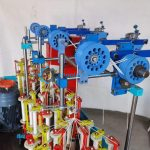Why are the majority of solid-state relays constructed as single-pole devices?
Solid-state relays (SSRs) are electronic switches that use semiconductors to control the flow of electricity. They have no moving parts, unlike electromechanical relays (EMRs)
Electromechanical Control Relays
An electromechanical relay (EMR) is a switch that is operated by an electromagnet. It turns a load circuit on or off by energizing an electromagnet, which opens or closes contacts…
Everything you need to know about motor starters
The magnetic contactor is primarily used to switch power in resistance heating elements, lighting, magnetic brakes, and heavy industrial solenoids.
In what way is a timing relay different from a standard control relay?
Timing relays are a type of relay that delays the switching action for a fixed or adjustable amount of time after a change in the control signal. This allows a…
Contactor Ratings, Enclosures, and Solid-State Types
The National Electric Manufacturers Association (NEMA) and the International Electrotechnical Commission (IEC) maintain guidelines for contactors. The NEMA standards for contactors differ from those of the IEC and it is…
What is the magnetic contactor?
The magnetic contactor is similar in operation to the electromechanical relay. Both have one important feature in common: contacts operate when the coil is energized
What are the uses of latching relay?
Latching relays are a type of relay that can maintain their state (on or off) even after the power is removed. This is because they use a mechanical latch or…
Motor Maintenance and Troubleshooting
In general, motors are very reliable machines that require little maintenance. But while a typical electric motor might be a low-maintenance item, it still requires regular maintenance if it is…
Knowledge of proper motor installation
Knowledge of proper installation techniques is vital to the effective operation of a motor. The following are some of the important motor installation procedures that need to be considered.






